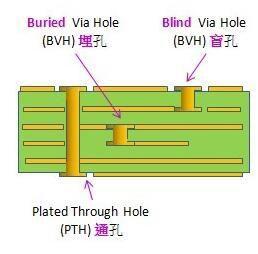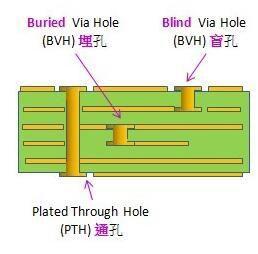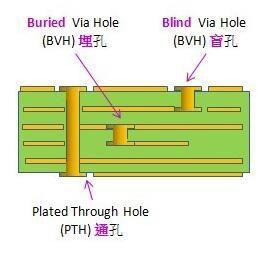
Date:2018-10-26 Categories:Industry News Hits:532
There are three kinds of drilling holes in printed circuit board (PCB), such as through hole, blind hole and buried hole.
Through hole (via), the copper foil circuit between the conductive patterns in different layers of the circuit board is conducted or connected by this kind of hole, but the copper plated hole of component leg or other reinforcement material cannot be inserted. Printed circuit board (PCB) is formed by stacking many copper foil layers. The reason why copper foils can't communicate with each other is that each layer of copper foil is covered with an insulating layer, so they need to rely on via for signal link, so they have the name of Chinese through hole.

The through hole of the circuit board must pass through the plug hole to meet the needs of the customer. In changing the traditional aluminum plug hole process, the solder mask and plug hole on the circuit board surface are completed by white mesh, which makes the production more stable, the quality more reliable and the application more perfect. With the rapid development of electronic industry, higher requirements have been put forward for the production process and surface mounting technology of printed circuit board (PCB). The plug hole technology of the through hole came into being, and it should also meet the following requirements: 1. There is only copper in the hole, and the solder mask can be plugged or not; 2. There must be tin and lead in the hole with a certain thickness requirement (4um) to avoid solder paste from entering the hole, resulting in tin beads hidden in the hole; 3. The through hole must have solder resist ink plug hole, opaque, no tin ring and tin bead, and must be flat 。
Blind hole is to connect the outermost circuit and the adjacent inner layer in printed circuit board (PCB) with electroplating hole. It is called blind pass because it is unable to see the opposite side. In order to increase the utilization of the space between the boards, blind holes come into use. A blind hole is a through hole on the surface of the printed circuit board.

The blind hole is located on the top and bottom surface of the circuit board, and has a certain depth. It is used to connect the surface circuit with the lower inner circuit. The depth of the hole generally has a specified ratio (aperture). Special attention should be paid to this production method. The drilling depth must be appropriate. If not, electroplating in the hole will be difficult. As a result, very few factories will adopt this manufacturing method. In fact, it is also possible to drill holes for the circuit layers that need to be connected in advance, and then glue them together at last. However, more precise positioning and positioning devices are needed.
Buried hole refers to the connection between any circuit layers inside the printed circuit board (PCB), but it is not connected with the outer layer, that is, there is no through hole extending to the surface of the circuit board.

This production process can not be achieved by bonding the circuit board and then drilling. Drilling operation must be carried out at the time of individual circuit layer. First, the inner layer is partially bonded, then the plating treatment is carried out, and finally all the bonding is carried out. Because the operation process is more laborious than the original through hole and blind hole, the price is also the most expensive. This process is usually used only for high-density circuit boards to increase the space utilization of other circuit layers.
In the production process of printed circuit board (PCB), drilling is very important. Drilling simple understanding is to drill the required through-hole on the copper clad laminate, which has the function of providing electrical connection and fixing components. If the operation is not correct, there will be problems in the through-hole process, and the device can not be fixed on the circuit board, which will affect the use of the circuit board, or even scrap the whole board. Therefore, drilling is very important.
The above information is from the Internet public data collation